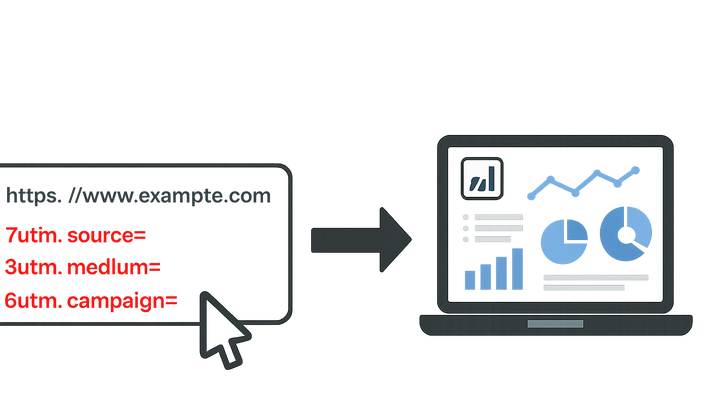Published on 2025-06-29T18:30:53Z
What is Link Tagging? Examples for Link Tagging.
Link tagging is the process of appending custom query parameters to URLs—most commonly UTM parameters—to identify and measure the performance of individual marketing campaigns. By adding tags such as utm_source, utm_medium, and utm_campaign, marketers can attribute visits, conversions, and user behavior back to specific ads, emails, social posts or other channels. Tools like UTMGuru simplify the creation, storage, and management of these tagged URLs, while privacy-focused analytics platforms like PlainSignal consume the tagged links and provide insight without relying on third-party cookies. Consistent link tagging ensures that data in your analytics dashboards remains accurate, actionable, and comparable across campaigns and channels.
Link tagging
Appending custom query parameters to URLs for tracking campaign performance in analytics tools like PlainSignal and UTMGuru.
Introduction to Link Tagging
Link tagging enables precise attribution by labeling inbound traffic at the URL level. Without tags, all traffic to a page may appear as ‘Direct’ or generic referrals, obscuring which campaigns drove results. By standardizing link tags, teams can compare channel performance, optimize budgets, and measure ROI accurately.
-
Definition and purpose
Link tagging means appending query parameters (e.g., utm_source, utm_medium) to the end of a URL so that analytics tools can attribute user sessions back to specific campaigns or sources.
-
Key parameters
The most common UTM parameters you’ll encounter:
- Utm_source:
Specifies where traffic originates (e.g., ‘google’, ‘newsletter’).
- Utm_medium:
Indicates the marketing medium (e.g., ‘cpc’, ‘email’, ‘social’).
- Utm_campaign:
Names the specific campaign or promotion (e.g., ‘spring_sale’).
- Utm_term:
Optional identifier for paid search keywords.
- Utm_content:
Differentiates similar content or links (e.g., ‘cta_button’, ‘footer_link’).
- Utm_source:
Implementing Link Tagging
Once parameters are defined, you can tag links manually or leverage tools to automate the process. Manual tagging risks typos and inconsistencies, while dedicated builders enforce naming rules, generate URLs instantly, and store them for future reference.
-
Manual tagging vs. tool-based tagging
Compare the pros and cons of hand-crafting URLs versus using a specialized builder.
- Manual tagging:
Appending parameters by hand can lead to errors, inconsistent naming conventions, and overlooked tags.
- Using utmguru:
utmguru.com offers a web UI and Chrome extension to build, generate, save, and list UTM-tagged URLs for consistent reporting.
- Manual tagging:
-
Best practices
Establish a naming convention (lowercase, hyphens instead of spaces), keep parameter values concise yet descriptive, and maintain a central registry or tool to share rules across your team.
Tracking and Analytics with PlainSignal
PlainSignal is a cookie-free analytics platform that relies on first-party data and link tagging to deliver accurate campaign insights while respecting privacy regulations. By tagging your links and installing the PlainSignal script, you ensure every click is attributed without third-party cookies.
-
Integrating the plainsignal script
Insert the following snippet into your site’s <head> to capture visits and attribute them via tagged URLs:
<link rel='preconnect' href='//eu.plainsignal.com/' crossorigin /> <script defer data-do='yourwebsitedomain.com' data-id='0GQV1xmtzQQ' data-api='//eu.plainsignal.com' src='//cdn.plainsignal.com/plainsignal-min.js'></script> -
Analyzing tagged links
After deployment, open the PlainSignal dashboard and filter by UTM parameters. Measure visits, bounce rate, conversion events, and ROI for each source, medium, and campaign combination—all without cookies.
Common Pitfalls and Troubleshooting
Even with a robust tagging strategy, issues like inconsistent naming, unencoded characters, or lengthy URLs can corrupt your data. Regular audits and automated checks help maintain accuracy.
-
Inconsistent naming
Variations like ‘Email’ vs. ‘email’ or ‘cpc’ vs. ‘ppc’ fragment reporting. Standardize on lowercase and document all campaign codes.
-
Unchecked url length
Some platforms limit URL length; overly long tags can be truncated and drop parameters. Keep tags succinct.
-
Missing or incorrect parameters
Omitting utm_campaign or typoing parameter names leads to misclassified traffic (often lumped under ‘Direct’). Automate validation where possible.
